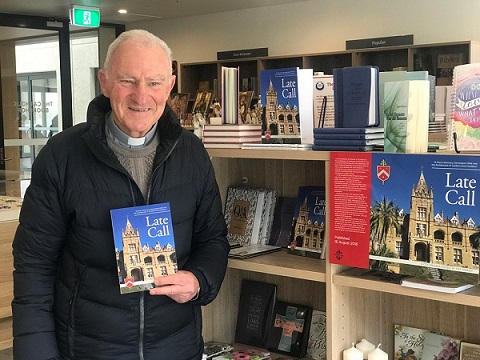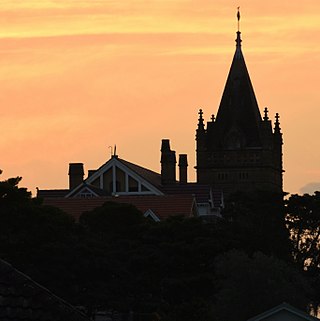Golden Jubilees of the first priests from St Paul’s National Late Vocations Seminary.

E.J. Cuskelly MSC, inaugural rector of St Paul's.
Tomorrow, we will acknowledge our MSC Golden Jubilarians, Arthur Stidwill, Len Helm, Ed Travers, Terry Herbert and the late Laurie Baylis.
This article appeared in the Canberra-Goulburn Archdiocese, Catholic Voice, written by Chris Gordon (who also has the photo credit)
Bishop Pat Power, editor of the book Late Call (2018) that tells the story of the 23 priests from the Canberra Goulburn Archdiocese ordained at St Paul’s Seminary in Kensington. Photo Chris Gordon.
Built in 1897, for years its Pyrmont sandstone walls stood at the centre of the Sacred Heart Monastery overlooking Kensington, both church and later school for local Catholics.
Today, that central building and those around it perform a range of functions, including use as a conference centre.
But for thirty shining years within the Monastery grounds operated a seminary for “older men,” an innovative idea at the time, giving men who received a late vocational call an opportunity to graduate in four years rather than the usual seven.
From 1968 until 1998, 281 priests were ordained at St Paul’s, 23 of them from the Canberra Goulburn Archdiocese.
“Twenty three of our best priests went through St Paul’s,” according to Emeritus Bishop Pat Power, editor of ‘Late Call’.
Bishop Power, a graduate of St Columba’s, Springwood and St Patrick’s, Manly, said he always had a great admiration for the 23 graduates of St Paul’s from this Archdiocese. For that reason he took on compiling the book as a labour of love to tell their stories.

His fascination with St Paul’s, aside from his personal fondness for the place where he attended many bishop’s conferences, stems from the wide range of backgrounds the seminarians came from.
“It was a seminary for late vocations and it was started by the Missionaries of the Sacred Heart,” Bishop Power said.
“In those days it was at least a seven year course for the priesthood, and the Missionaries of the Sacred Heart were looking for a shorter course for some of their people who were interested in being Missionaries of the Sacred Heart,” Bishop Power said.
“So what St Paul’s offered was a four year course rather than a seven year course. From there it developed that some of the bishops were interested, and then the idea expanded to be a national seminary.”
The process of collating the book began last year for Bishop Power while attending the Archdiocesan retreat. He began reaching out to the former seminarians to see who was interested in the project and when there seemed sufficient interest, he got them to write a potted version of their stories (between 500 and 1000 words). Of the original 23, 17 are still living and others were sought to write for those who have already passed away.
“The stories themselves are simply written,” Bishop Power said.
“I found, when I sat down to read them, that the stories spoke for themselves in a way that touched my heart and I believe in a way that would speak lucidly to the readers of this book. They are just a nice collection of stories.”
Bishop Power points out that the reason that St Paul’s closed was related to the reason it opened in the first place. In 1968, the seven year requirement at traditional seminaries was rigid, but by 1998 there was more flexibility, accommodating late call seminarians as well.
Today, the buildings remain although few traces of the seminary do. New stories are being created and told around those old buildings, but with the help of this book, some of the old stories will now be remembered as well.

Part of the statement of closure: St Paul's National Seminary was opened in 1968 as a collaborative response of the Australian Catholic Bishops' Conference and the Missionaries of the Sacred Heart to the signs of those times regarding older men serving the Church as priests. St Paul's has been involved in adult education of the lay faithful, and more recently has offered a degree programme in theology.
We have reached a point in time, however, when there is no longer a need for a specialist Seminary to train older men for the priesthood and service in the Church. On the one hand, as was to be expected, the number of aspirants from this age group has diminished markedly over the years, and on the other hand, other Seminaries and Houses of Formation now take students of much more mature yearsthan they did before. Consequently, the Australian Catholic Bishops' Conference and the Missionaries of the Sacred Heart have decided to close St Paul's as the National Seminary for late vocations, at the end of 1998. This has been done with regret, but with trust in the providence of God, and with much satisfaction over what has been achieved at St Paul's.
Signed by Cardinal Edward Clancy of Sydney and Brian Gallagher MSC, the then Provincial.